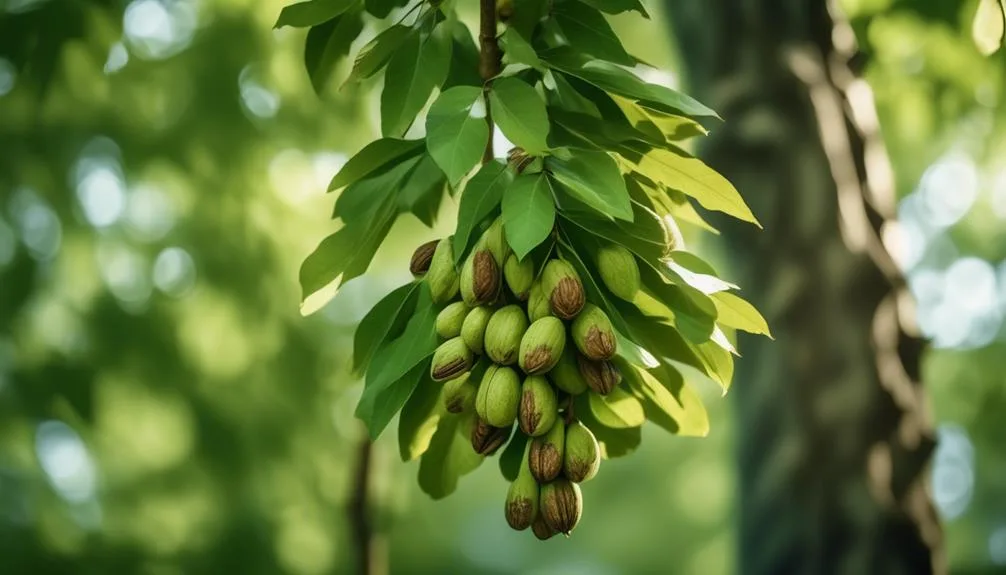Ever wondered why hickory trees produce nuts? It's not just about feeding squirrels.
The process is a complex interplay of biology, ecology, and the environment. Unraveling this nutty mystery reveals the intricate web of life surrounding these humble tree fruits.
But we'll get to that in just a moment.
Hickory Tree Characteristics
Hickory trees are known for their tall, straight trunks and distinctive compound leaves, making them a striking addition to any landscape. These trees aren't just beautiful; they also provide significant nutritional value through their nuts.
The hickory nut is rich in protein, healthy fats, and various essential minerals, making it a valuable food source for wildlife and humans alike. In fact, the nuts produced by hickory trees are a vital food source for many animals, including squirrels, deer, and birds.
Beyond their nutritional value, hickory trees also serve as a crucial wildlife habitat, providing shelter and nesting sites for various species. Their strong, durable wood is also highly valued for its use in making furniture, tool handles, and smoking meats.
Nut Production Process
After learning about the valuable nutritional and ecological contributions of hickory trees, it's important to understand the intricate process involved in their nut production.
The pollination process in hickory trees is fascinating. These trees rely on wind to carry their pollen from the male flowers to the female flowers, where fertilization occurs. Once fertilized, the female flowers develop into hickory nuts.
The nuts are encased in a hard shell that falls from the tree when mature. This is where the seed dispersal process begins. Squirrels and other small mammals are essential to the hickory nuts' dispersal. They bury the nuts for future consumption but often forget some, allowing them to germinate and grow into new hickory trees.
This intricate process ensures the continuation of hickory tree populations in their natural habitats.
Importance of Hickory Nuts
The nutritional and ecological significance of hickory nuts can't be overstated in the natural world. Hickory nuts are packed with essential nutrients like protein, healthy fats, and fiber, making them a valuable food source for both humans and wildlife.
For wildlife, hickory nuts provide vital sustenance, supporting various species like squirrels, chipmunks, deer, and birds. The high fat content in hickory nuts helps animals build up their fat reserves for the winter, ensuring their survival during harsher months.
Additionally, the nutritional benefits of hickory nuts extend to humans, offering a delicious and nutrient-dense food option. Whether eaten raw, roasted, or incorporated into recipes, hickory nuts provide a rich source of energy and essential nutrients.
Their role in supporting wildlife consumption and providing nutritional benefits underscores their importance in the natural ecosystem.
Environmental Factors
As you consider the significance of hickory nuts, it becomes clear that various environmental factors play a crucial role in their production and sustainability. Understanding the influence of climate effects and soil composition on hickory trees is essential for appreciating their ability to produce an abundant crop of nuts.
Here's how these environmental factors impact hickory nut production:
- Climate effects: The climate, including temperature, rainfall, and sunlight, directly affects the growth and development of hickory trees. Adequate sunlight and a suitable temperature range are crucial for the trees to produce healthy nuts.
- Soil composition: The composition of the soil, including its pH, nutrient levels, and drainage capacity, significantly influences the overall health and productivity of hickory trees.
Considering these environmental factors is essential for understanding the conditions that support the sustainable production of hickory nuts.
Cultural and Historical Significance
With deep roots in American folklore and a long-standing presence in indigenous cultures, hickory trees and their nuts hold significant cultural and historical importance.
In many Native American cultural traditions, hickory nuts weren't only a staple food source but also played a role in various folklore legends. These trees were revered for their strength and resilience, often symbolizing endurance and survival in many stories. Additionally, hickory nuts were used in traditional medicine and ceremonies, further emphasizing their cultural significance.
In early American history, hickory wood was highly valued for its durability and was used in crafting tools, furniture, and even weapons.
The enduring presence of hickory trees in cultural practices and folklore reflects their deep-rooted significance in shaping the historical and cultural narrative of the regions they inhabit.
Conclusion
In the end, the hickory tree's nut production proves to be an essential component of the ecosystem. It sustains wildlife, contributes to forest health, and serves as a longstanding resource for humanity.
Its significance extends far beyond the woods, prompting us to consider the intricate interplay between nature and culture.
Mark Hoffman is a dedicated arborist and tree care specialist with over a decade of experience. His love for trees began when he visited Yosemite National Park as a teenager and was awestruck by the giant sequoias. Mark pursued his passion by studying forestry at Michigan Technological University, where he earned a Bachelor of Science degree.
Since then, he has worked tirelessly in the field of arboriculture, helping to preserve and protect trees in his community. His expertise and dedication have made him a respected leader in the industry and a valuable resource for anyone seeking advice on tree care.
